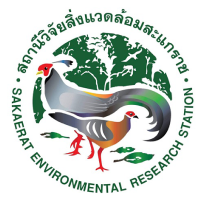Keywords :
Plant Silica; Vegetation Changes; Tropical Seasonal Forest
บทคัดย่อ :
Tropical seasonal forest, widely distributed in Thailand and neighbouring countries, has been exposed to human impact since the early settlers started to use the forest. Vegetation changes in the region are important in considering the influence of global warming and human activities. This study applied on-site analysis of plant silica in seasonally dry forests
to estimate past vegetation. Three sites were selected in different forests in Sakaerat, northeast Thailand: deciduous dipterocarp forest (DDF); mixed deciduous forest (MDF); and dry evergreen forest (DEF). On each site, soil samples were collected every 10 cm down to a depth of one meter. Charcoal pieces in the soil layers were also collected for radio carbon dating. Many Dipterocarpaceae species characteristic of dry forests, such as Hopea ferrea, Shorea roxburghii and S. siamensis produced silica in their leaves. Arundinaria pusilla, a typical
bamboo species in DDF, also produced distinguishable silica. From one pit in DDF (SD1), carbon dating of charcoal pieces collected from 40 cm and 20 cm depths were dated as 1157(+-)20 and 204(+-)19 years BP, respectively. In SD1, silica derived from current vegetation was found in the layers up to 30 cm from the surface. In another pit in DDF (SD2), charcoal pieces collected from 50 cm and 40 cm deep were dated as 1255(+-)18 and 1447(+-)22 years BP, respectively. Silica derived from current vegetation was found in the charcoal layers and above. On the other hand in MDF, charcoal collected from 67 cm deep was dated as 4390(+-)22 years BP. Silica derived from DDF was found at depths of up to 43 cm, except in the surface layer. Conclusions from the results are: 1) current DDF already existed about 1500 years ago; and 2) later some DDF was replaced with MDF.
เอกสารอ้างอิง :
Eguchi, S., Okada, N., Siripatanadilok, S., & Veenin, T. (2009). Opal phytolith fossils in the soil of tropical seasonal forest in Sakaerat, northeast Thailand. Proceedings of the FORTROPII: Tropical Forestry Change in a Changing World, 5, 149-156.



